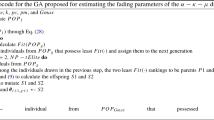Abstract
Finite-state HMM error models are an established powerful tool for capturing temporal characteristics of fading channels. They make network simulations much more practical and fast while developing and testing higher layer wireless system protocols and designing interleaving and FEC schemes. This paper has introduced two new Genetic Algorithm (GA) based approaches, namely, GA-S and GA-B as an alternative to HMM error models, for the accurate learning of error statistics of autocorrelation function (ACF) and error-run distributions. Validity comparisons of fit obtained show that the GA method is better than both the conventional Baum–Welch algorithm (BWA) and Semi-hidden Markov model (SHMM) methods, even when the target sequences are as short as 1000 in length. The independent elements of the [A] and [B] parameters of BWA used as chromosomes of the population space are used for error generation within the Genetic Algorithm. Mean square error of statistical properties of the error sequences is used to determine fitness of the chromosomes unlike other works using average log-likelihood ratio. Applicability has been tested by numerical simulations using error sequences of different lengths as well as target sequences of fixed length from an OFDM transceiver system under different fading rates. A T s spaced time-delay model of the propagation channel with a fixed power delay profile has been used. For slow faded channels or when long sequences of error free intervals poses difficulties for BWA training, the GA method proves to be an excellent alternative for fast and accurate modeling of the error bursts. Unlike the computationally cumbersome BWA or the simplified SHMM approach, the GA model is capable of arriving at desired levels of accuracy with two to three states, in contrast to the Markov models needing a much higher number of states.







Similar content being viewed by others
References
He, Y., Salih, O. S., Wang, C. X., & Yuan, D. (2013). Deterministic process-based generative models for characterizing packet-level bursty error sequences. Wireless Communications and Mobile Computing, 15(3), 421–430. doi:10.1002/wcm.2356.
Sadeghi, P., Kennedy, R. A., Rapajic, P. B., & Shams, R. (2008). Finite-state Markov modeling of fading channels—A survey of principles and applications. IEEE Signal Processing Magazine, 25(5), 57–80.
Verikoukis, C. V. (2004). An adaptive hidden Markov model for indoor OFDM based wireless systems. Journal of Telecommunications and Information Technology, 2, 61–65.
Poikonen, J. (2009). A finite-state simulation model for OFDM over frequency-selective fast fading channels. IEEE International Symposium on Broadband Multimedia Systems and Broadcasting (BMSB’09), Bilbao. doi:10.1109/ISBMSB.2009.5133766.
Ranjan, R., & Mitra, D. (2015). HMM modeling for OFDM-BER performance. AEUE-International Journal of Electronics and Communications, 69(1), 18–25. doi:10.1016/j.aeue.2014.07.009.
Akbar, I. A. (2007). Statistical analysis of wireless systems using Markov models. Ph.D. thesis, Virginia Polytechnic Institute and State University, Blacksburg, Virginia.
Goldberg, D. E. (2006). Genetic algorithms. Pearson Education.
Melanie, M. (1999). An introduction to genetic algorithms. Cambridge: MIT Press.
Pelikan, M. (2010). Genetic algorithms. Missouri Estimation of Distribution Algorithms Laboratory (MEDAL) Report No. 20010007, University of Missouri. Accepted by the Encyclopedia of Operations Research and Management Science (EORMS) (Wiley).
Zhi-Jin, Z., Shi-Lian, Z., Chun-Yun, X., & Xian-Zheng, K. (2007). Discrete channel modelling based on genetic algorithm and simulated annealing for training hidden Markov model. Chinese Physics, 16(6), 1619–1623.
Turin, W., & Sondhi, M. (1993). Modeling error sources in digital channels. IEEE Journal on Selected Areas in Communications, 11(3), 340–347.
Sivaprakasam, S., & Shanmugan, K. S. (1995). An equivalent Markov model for burst errors in digital channels. IEEE Transactions on Communications, 43(234), 1347–1355.
Tranter, W. H., Shanmugan, K. S., Rappaport, T. S., & Kosbar, K. L. (2004). Principles of communication systems simulation with wireless applications. New Jersey: Prentice Hall, Professional Technical Reference.
Ranjan, R. & Mitra, D. (2012). Order estimation of HMM discrete channel model for OFDM systems. In International Conference on Communications, Devices and Intelligent Systems (CODIS’12) (pp. 41–44), Jadavpur University, Kolkata, India, Dec 28–29, 2012. (IEEE Xplore, doi:10.1109/CODIS.2012.6422131).
Ranjan, R., & Mitra, D. (2013). Performance of HMM based burst error modeling for CDMA and OFDM transmissions. Journal of Wireless Networking and Communications, 3(5), 63–73.
Author information
Authors and Affiliations
Corresponding author
Rights and permissions
About this article
Cite this article
Ranjan, R., Mitra, D. GA Optimized HMM Error Model for OFDM. Wireless Pers Commun 96, 621–633 (2017). https://doi.org/10.1007/s11277-017-4191-6
Published:
Issue Date:
DOI: https://doi.org/10.1007/s11277-017-4191-6




